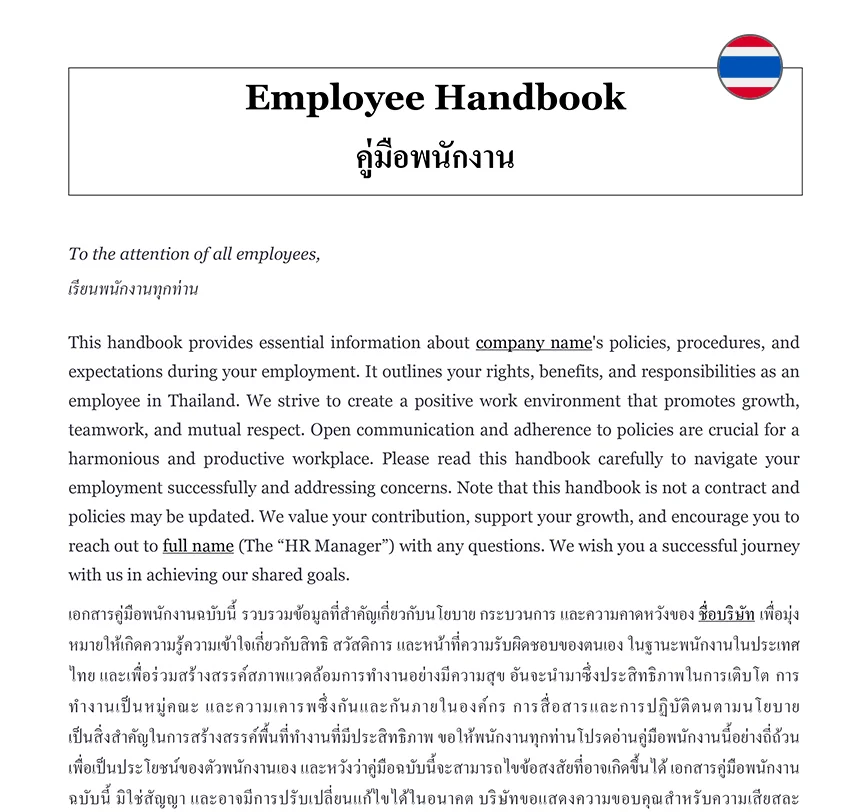Ready to use legal template
Drafted by experienced lawyers
Certified Thai-English translation
Ready to use legal template
Drafted by lawyers
Translated in Thai-English
Learn more about Employee Handbook
An Employee Handbook is an essential document that outlines a company’s policies, procedures, expectations, and employee rights in a clear and organized manner. It serves as a practical guide for both employers and employees, covering important topics such as workplace conduct, benefits, leave entitlements, disciplinary procedures, and legal compliance. In Thailand, having a well-prepared Employee Handbook not only ensures consistent internal communication but also helps businesses comply with the Labour Protection Act and other local employment regulations. It promotes a transparent and professional work environment while protecting the interests of both parties. Download our Employee Handbook available in an easy to edit Word format and drafted by expert in English and Thai.
Table of contents
-
What is an Employee Handbook in Thailand?
-
What should an Employee Handbook include?
-
Is an Employee Handbook mandatory in Thailand?
-
How can an Employee Handbook benefit employers?
-
How does the Employee Handbook ensure compliance with Labor Laws?
-
Can Employees request changes to the Employee Handbook?
-
How do employers update the Employee Handbook policies?
What is an Employee Handbook in Thailand?
An Employee Handbook in Thailand is a comprehensive document that outlines the policies, procedures, rules, and guidelines that govern the employment relationship between an employer and its employees.
It serves as a centralized resource providing essential information about the company’s culture, expectations, and benefits, as well as the rights and responsibilities of employees.
The handbook serves as a reference guide for employees to understand the company’s values, code of conduct, disciplinary procedures, leave policies, and other important aspects of their employment. In Thailand, an Employee Handbook plays a crucial role in promoting consistency, transparency, and compliance with labor laws while fostering a positive work environment for both employers and employees.
What should an Employee Handbook include?
An Employee Handbook should be comprehensive and cover essential policies, procedures, and guidelines relevant to the employment relationship. While the specific content may vary based on the organization’s size, industry, and culture, here are some common elements that an Employee Handbook in Thailand should include:
1. Employment Basics
Equal opportunity employment: Ensuring fair treatment and non-discrimination.
Recruitment and selection process: Guidelines for hiring and candidate selection.
Background checks: Procedures for conducting background checks on potential employees.
Referrals: Policies for employee referrals and rewards.
Attendance: Expectations for punctuality and attendance.
2. Workplace Policies
Confidentiality and data protection: Safeguarding sensitive company and employee information.
Harassment and violence: Policies addressing various forms of harassment in the workplace.
Workplace safety and health: Guidelines for maintaining a safe and healthy work environment.
Preventative action: Steps to prevent workplace incidents and accidents.
Emergency management: Procedures for handling emergencies and evacuation.
Smoking: Policies regarding smoking in the workplace.
Drug-free workplace: Prohibition of drug use on company premises.
3. Employee Code of Conduct
Dress code: Expectations for appropriate attire.
Cyber security and digital devices: Guidelines for safe and responsible use of company technology.
Internet usage: Policies for internet usage during work hours.
Cell phone: Guidelines for cell phone use in the workplace.
Social media: Policies governing employee use of social media platforms.
Conflict of interest: Policies addressing situations where personal interests conflict with company interests.
Employee relationships: Guidelines for professional relationships among employees.
Workplace visitors: Policies for visitors and guests in the workplace.
4. Employee Compensation and Development
Compensation status: Information on salary structure and payment procedures.
Overtime: Guidelines for compensating overtime work.
Performance management: Processes for evaluating and managing employee performance.
Employee training and development: Opportunities for employee growth and development.
5. Employee Benefits and Perks
Employee health: Information on healthcare benefits and coverage.
Workers’ compensation: Policies related to workplace injuries and insurance coverage.
Work from home: Guidelines for remote working arrangements.
Employee expenses: Procedures for reimbursement of approved expenses.
Company car: Policies regarding the use and maintenance of company-provided vehicles.
6. Working Hours, PTO and Vacation
Working hours: Expectations for regular work hours and breaks.
Paid time off (PTO): Guidelines for requesting and using paid leave.
Holidays: List of company-recognized holidays and leave entitlements.
Sick leave: Policies for reporting and taking sick leave.
Parental leave: Entitlements and procedures for parental leave.
7. Employee Resignation and Termination
Progressive discipline: Steps taken in addressing employee performance or behavioral issues.
Resignation: Procedures for employees who wish to resign from their positions.
Termination: Guidelines and procedures for terminating an employee’s employment.
References: Policies regarding providing employee references.
- Remarks:
It is important to note that the content of the handbook may vary depending on the nature of the organisation, industry-specific regulations, and company policies.
Is an Employee Handbook mandatory in Thailand?
Unlike some countries, Thailand’s labor laws do not explicitly stipulate the necessity of an Employee Handbook.
However, having an Employee Handbook is still highly recommended for employers in Thailand. It serves as a valuable tool to communicate important policies, procedures, and guidelines to employees in a clear and consistent manner. An Employee Handbook helps set expectations, promotes uniformity in the workplace, and provides employees with essential information about their rights, benefits, and responsibilities.
An Employee Handbook can be beneficial in case of disputes or legal issues. It can serve as evidence that the company has communicated its policies and procedures to employees, promoting a fair and transparent work environment.
While not legally mandatory, many employers in Thailand choose to create an Employee Handbook to establish a well-organized and professional work environment. Employers should also keep in mind that labor laws and regulations can change, so it is essential to stay updated on any developments that may impact employment practices in Thailand.
How can an Employee Handbook benefit employers?
An Employee Handbook provides employers with various advantages, offering clear communication of company policies and procedures to employees in a consistent manner.
It ensures compliance with employment laws, reduces misunderstandings, and sets clear expectations for behavior and performance, fostering a positive work culture. The handbook serves as a reference guide for employees, facilitating onboarding and promoting workplace safety. It outlines performance management procedures, offers conflict resolution avenues, and helps mitigate liability.
The handbook reflects the company’s culture and branding, empowering employees and contributing to increased productivity and job satisfaction. Overall, the Employee Handbook is a valuable resource that benefits employers by promoting efficiency, consistency, and a harmonious work environment.
How does the Employee Handbook ensure compliance with Labor Laws?
The Employee Handbook ensures compliance with labor laws by communicating company policies and legal information to employees, promoting consistency in policy application, providing updates to align with changing regulations, obtaining employee acknowledgment of policies, offering structured dispute resolution procedures, addressing wage and hour compliance, outlining leave policies, documenting training efforts, protecting confidential information, and providing a framework for enforcing policies that align with labor laws.
Regular updates and effective communication of policies help maintain compliance with labor laws and safeguard both employee rights and company interests.
Can Employees request changes to the Employee Handbook?
Yes, employees can request changes to the Employee Handbook. In many organizations, the Employee Handbook is considered a living document that can be updated and revised as needed. If employees identify a policy or section that they believe needs improvement or modification, they can raise their concerns to the human resources department or management.
The process for requesting changes to the Employee Handbook may vary from company to company, but it typically involves the following steps:
1. Submission of Request: Employees can submit their proposed changes or suggestions for the Employee Handbook in writing or through a designated channel provided by the company.
2. Review and Evaluation: The human resources department or relevant stakeholders will review the suggested changes to assess their feasibility, alignment with company values, and compliance with labor laws and regulations.
3. Consideration and Approval: After careful evaluation, management will determine whether the proposed changes should be incorporated into the Employee Handbook. Some changes may be immediately approved, while others may require further discussion or legal review.
4. Communication: Once approved, the changes will be communicated to all employees through updated versions of the Employee Handbook. It’s essential to ensure that employees are aware of the changes and have access to the revised policies.
5. Acknowledgment: Employees may be asked to acknowledge that they have read and understood the updated policies by signing an acknowledgment form or electronically confirming their awareness.
It’s crucial for companies to foster a culture of open communication and encourage employees to provide feedback on policies and procedures. By involving employees in the process of updating the Employee Handbook, companies can create a more inclusive and engaged workforce. However, it’s also essential for any changes to be consistent with legal requirements and company values to maintain compliance and fairness in the workplace.
How do employers update the Employee Handbook policies?
Updating the Employee Handbook is a systematic process that ensures compliance with labor laws and company policies. Employers begin by reviewing existing policies and identifying necessary changes, seeking legal and management approval. Drafting the updates, consulting HR and legal teams, and communicating changes to employees follow.
Training sessions are conducted to ensure understanding, and employees acknowledge receipt of the updated Handbook. The revised document is distributed, and policies are consistently enforced. Regular reviews are undertaken to stay current with employment regulations and address emerging issues, maintaining a clear and effective set of guidelines for the workforce.
SPECIAL OFFER
HR Pro
15 Document Package
Essential documents for managing employees in Thailand
Share information
Why Themis Partner?
Easy legal documents at your fingertips
Make trusted documents for hundreds of purposes.
Hundreds of documents
Instant access to our entire library of documents for Thailand.
24/7 legal support
Quick legal advice from our network of qualified lawyers.
Easily customized
Editable Word documents, unlimited revisions and copies.
No translation fees
Certified Thai-English translation included for all documents.
Legal and Reliable
Documents written by lawyers that you can use with confidence.
Free consultation
Free lawyer consultation on each new matter.




